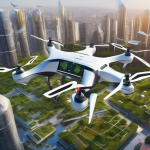Cybersecurity in IT: How AI Is Strengthening Defenses

In today’s digital age, the landscape of cybersecurity is constantly evolving, and with it comes the need for robust defenses against increasingly sophisticated threats. Enter artificial intelligence (AI)—a game changer in the realm of IT security. Imagine having a vigilant guard that never sleeps, tirelessly analyzing every byte of data flowing through your network. That’s what AI brings to the table! It enhances security measures, identifies threats, and protects sensitive data like never before.
AI technologies are not just a trend; they are revolutionizing how organizations approach threat detection. By processing vast amounts of data in real-time, AI can pinpoint anomalies that may indicate a breach. Think of it as having a super-sleuth on your team, capable of noticing the tiniest details that human eyes might miss. This capability allows for quicker responses to emerging threats, ensuring that organizations can stay one step ahead of cybercriminals.
Moreover, the power of predictive analytics cannot be overstated. With AI, organizations can forecast potential cyber threats before they even materialize. This proactive approach is akin to having a weather forecast for storms—knowing when to batten down the hatches can save a lot of trouble down the line. By strengthening defenses ahead of time, companies can significantly enhance their overall security posture.
As we delve deeper into the world of AI in cybersecurity, we find that machine learning algorithms are pivotal. These algorithms continuously learn from new data, adapting to evolving attack patterns. It’s like training a dog; the more you teach it, the better it gets at recognizing commands and responding appropriately. This adaptability makes AI a vital component of modern cybersecurity strategies.
In conclusion, embracing AI in cybersecurity is not just an option; it’s a necessity for organizations aiming to protect their valuable data and maintain trust in their operations. The future looks bright, but it’s essential to navigate the challenges and ethical considerations that come with this powerful technology.
The Role of AI in Threat Detection
In today’s digital landscape, the importance of threat detection cannot be overstated. With cyber threats evolving at an alarming pace, organizations are turning to artificial intelligence (AI) as a game-changer in their cybersecurity arsenal. Imagine having a vigilant guardian that never sleeps, constantly analyzing mountains of data to pinpoint anomalies. This is precisely what AI brings to the table. By leveraging advanced algorithms, AI can sift through vast amounts of information in real-time, identifying potential security breaches before they escalate into significant issues.
AI technologies excel in recognizing patterns that would be nearly impossible for humans to detect quickly. For instance, while a human analyst might take hours to review logs, AI can process this data in seconds, delivering insights and alerts almost instantaneously. This capability is crucial for organizations that need to respond swiftly to emerging threats. The integration of AI into threat detection systems allows for a proactive approach, where potential vulnerabilities can be addressed before they are exploited.
Additionally, AI’s ability to learn from new data makes it a formidable ally in the fight against cybercrime. As it encounters new threats, it continually refines its detection capabilities, adapting to the ever-changing landscape of cyberattacks. This machine learning aspect means that the more data it processes, the smarter it becomes, creating a dynamic defense mechanism that evolves alongside threats.
In summary, the role of AI in threat detection is not just about speed; it’s about enhancing the overall security posture of organizations. By integrating AI-driven solutions, businesses can significantly reduce their risk of falling victim to cyberattacks, ensuring that they stay one step ahead in this ongoing battle for cybersecurity.
Predictive Analytics for Cyber Defense
In the ever-evolving world of cybersecurity, predictive analytics powered by artificial intelligence is emerging as a game-changer. Imagine having a crystal ball that not only predicts potential cyber threats but also helps organizations fortify their defenses before an attack occurs. This proactive approach is crucial in a landscape where cybercriminals are becoming increasingly sophisticated. With the ability to analyze historical data and identify patterns, predictive analytics enables businesses to stay one step ahead of potential threats.
By leveraging vast datasets, predictive analytics can forecast possible vulnerabilities within an organization’s infrastructure. For instance, it can analyze previous breach attempts, user behaviors, and even external threat intelligence to identify weak spots that require immediate attention. This is akin to having a seasoned detective on your team, always on the lookout for signs of trouble. As a result, organizations can implement targeted security measures to mitigate risks before they escalate into full-blown attacks.
Furthermore, predictive analytics not only enhances the security posture but also optimizes resource allocation. By identifying high-risk areas, organizations can focus their efforts on the most critical aspects of their cybersecurity strategy, ensuring that both time and resources are utilized effectively. This strategic approach is essential, especially for businesses with limited cybersecurity budgets. Ultimately, the integration of predictive analytics into cyber defense strategies leads to a more resilient and prepared organization.
To illustrate the impact of predictive analytics, consider the following table showcasing its benefits:
| Benefit | Description |
|---|---|
| Proactive Defense | Identifies potential threats before they materialize, allowing for timely intervention. |
| Resource Optimization | Helps allocate resources effectively by focusing on high-risk areas. |
| Enhanced Threat Intelligence | Utilizes historical data to improve understanding of attack patterns and trends. |
In conclusion, predictive analytics is not just a buzzword; it’s a vital component of modern cyber defense strategies. By embracing this technology, organizations can significantly enhance their ability to predict, prepare for, and respond to cyber threats, ultimately safeguarding their sensitive data and maintaining trust with their customers.
Machine Learning Algorithms
In the ever-evolving realm of cybersecurity, play a pivotal role, acting like a vigilant security guard who never sleeps. These algorithms are designed to continuously learn from new data, which means they can adapt and improve their threat detection capabilities over time. Imagine a detective who gets smarter with every case they solve; that’s essentially what machine learning does in the context of cyber defense. By analyzing patterns and behaviors, these algorithms can identify anomalies that may indicate a potential security breach.
One of the most exciting aspects of machine learning is its ability to recognize evolving attack patterns. Cybercriminals are always on the lookout for new ways to infiltrate systems, and traditional security measures can sometimes lag behind these innovations. However, machine learning algorithms can swiftly adapt to these changes, making them vital for modern cybersecurity strategies. They act as a dynamic shield, constantly updating themselves to fend off the latest threats.
To illustrate the impact of machine learning in cybersecurity, consider the following table showcasing its key benefits:
| Benefit | Description |
|---|---|
| Real-time Threat Detection | Machine learning algorithms analyze data streams in real-time to catch threats as they emerge. |
| Adaptive Learning | These algorithms improve their accuracy over time by learning from previous incidents. |
| Reduced False Positives | By understanding normal behavior, machine learning helps minimize false alarms. |
In conclusion, the integration of machine learning algorithms into cybersecurity frameworks is not just a trend but a necessity. They provide organizations with the agility needed to counteract sophisticated threats effectively. As we move forward, the importance of these algorithms will only continue to grow, establishing them as a cornerstone of a robust cybersecurity strategy.
Behavioral Analysis
In the ever-evolving landscape of cybersecurity, has emerged as a game-changer. Imagine having a security guard who not only watches the entrance but also knows the usual patterns of everyone entering and leaving. That’s precisely what AI-driven behavioral analysis tools do—they monitor user behavior and network activity to identify unusual patterns that could signal a security breach or insider threat.
These tools utilize advanced algorithms to establish a baseline of normal behavior for users and systems. When deviations from this norm occur, alarms are triggered, allowing security teams to investigate potential threats before they escalate. For example, if an employee who usually logs in from a specific location suddenly accesses the system from a different country, the system can flag this as suspicious activity.
Moreover, the effectiveness of behavioral analysis lies in its ability to adapt. As more data is collected, the algorithms learn and refine their understanding of what constitutes typical behavior, enhancing their detection capabilities. This not only improves the accuracy of threat identification but also reduces the number of false positives, which can overwhelm security teams and lead to alert fatigue.
To illustrate the impact of behavioral analysis, consider the following table:
| Behavioral Indicators | Potential Threats |
|---|---|
| Unusual login times | Unauthorized access attempts |
| Accessing sensitive files not typically viewed | Data exfiltration |
| Multiple failed login attempts | Brute-force attacks |
In conclusion, behavioral analysis is not just a tool; it’s a vital component of a proactive cybersecurity strategy. By continuously monitoring and analyzing behavior, organizations can significantly enhance their incident response efforts and stay one step ahead of cybercriminals.
Automated Response Systems
In today’s digital age, the speed of response is crucial when it comes to cybersecurity. are game-changers in this realm, acting like a vigilant guard that never sleeps. Imagine a security system that not only detects a break-in but also locks the doors, calls the police, and alerts the homeowner—all in a matter of seconds. That’s the power of automation in cybersecurity.
These systems utilize artificial intelligence to monitor network traffic continuously, analyzing patterns and identifying potential threats. When a threat is detected, the system springs into action, executing predefined protocols to mitigate the risk. This immediate reaction is vital because, in the world of cyberattacks, every second counts. Delays can lead to significant data breaches, financial losses, and even reputational damage.
Here’s how automated response systems enhance cybersecurity:
- Rapid Threat Mitigation: By automatically isolating affected systems, these tools prevent the spread of malware and minimize damage.
- Consistent Monitoring: Unlike human operators, automated systems can monitor 24/7 without fatigue, ensuring no threat goes unnoticed.
- Data-Driven Decisions: They leverage machine learning algorithms to adapt their responses based on evolving threats, improving their effectiveness over time.
However, while automated response systems are incredibly effective, they are not a one-size-fits-all solution. Organizations must tailor these systems to their specific needs, ensuring that the automated responses align with their overall cybersecurity strategy. This balance between automation and human oversight is essential to create a fortified defense against the ever-evolving landscape of cyber threats.
Integration with Existing Security Systems
In today’s fast-paced digital world, organizations are constantly seeking ways to enhance their cybersecurity measures without completely overhauling their existing systems. The integration of AI solutions with current security frameworks is a game-changer, allowing businesses to bolster their defenses while maintaining operational continuity. Imagine trying to fix a car while still driving it; that’s what integrating AI into existing security systems feels like—challenging yet essential.
By leveraging AI tools, companies can create a more robust cybersecurity environment that synergizes human expertise with machine efficiency. For instance, when AI is integrated into traditional security systems, it can analyze data from various sources, such as firewalls, intrusion detection systems, and endpoint security solutions. This holistic approach enables security teams to gain deeper insights into potential threats and vulnerabilities.
Moreover, AI can enhance incident response capabilities by automating routine tasks and providing valuable recommendations based on real-time data analysis. This not only reduces the workload on security personnel but also ensures that they can focus on more complex issues that require human judgment. To illustrate this, consider the following benefits of integration:
- Seamless Data Sharing: AI can facilitate the smooth exchange of information between different security tools, improving overall situational awareness.
- Enhanced Threat Intelligence: By aggregating data from multiple sources, AI can identify patterns and trends that may go unnoticed in isolated systems.
- Cost-Effectiveness: Integrating AI with existing systems can be more economical than replacing them entirely, allowing organizations to maximize their current investments.
In conclusion, the integration of AI into existing security systems is not just an option; it’s a necessity for organizations that wish to stay ahead of cyber threats. As the landscape of cyberattacks continues to evolve, so too must our strategies for defense. Embracing AI integration can provide the edge needed to safeguard sensitive data and maintain trust in a digital-first world.

The Future of AI in Cybersecurity
The future of AI in cybersecurity is not just promising; it’s downright exhilarating! As technology evolves at breakneck speed, AI is set to become the backbone of our defense mechanisms against ever-growing cyber threats. Imagine a world where machines not only detect threats but also predict them before they even occur. This isn’t science fiction; it’s the reality that’s unfolding right before our eyes!
Advancements in AI will empower organizations to develop more sophisticated security frameworks. For instance, we can expect the integration of natural language processing and deep learning algorithms that can analyze not just data but also the context behind it. This means identifying potential threats based on behavioral patterns and even predicting the next move of cybercriminals. With AI at the helm, companies can stay one step ahead, transforming from a reactive to a proactive security posture.
Moreover, the rise of cloud-based AI solutions will democratize access to advanced cybersecurity tools. Smaller businesses, which often lack the resources for comprehensive security measures, will benefit greatly. With affordable AI-driven solutions, they’ll be able to leverage powerful analytics and automated defenses, leveling the playing field against larger corporations.
However, it’s crucial to consider the challenges that lie ahead. As we embrace AI, we must also address issues like data privacy and algorithm biases. Organizations will need to implement robust frameworks to ensure ethical AI usage, maintaining a balance between security and individual rights. The future of AI in cybersecurity is bright, but it requires a concerted effort to navigate the ethical landscape.
In conclusion, the integration of AI in cybersecurity is not just a trend; it’s the future. As we harness its potential, we must remain vigilant about the associated challenges. The journey ahead may be complex, but with collaboration and innovation, we can create a secure digital environment for everyone.
Challenges and Limitations
While the integration of AI in cybersecurity offers remarkable advantages, it also brings a set of challenges and limitations that organizations must navigate. One primary concern is data privacy. As AI systems require vast amounts of data to function effectively, organizations must ensure that they are not infringing on individual rights or exposing sensitive information during the data collection process. This balancing act can be quite tricky.
Another significant challenge is algorithm bias. AI systems are only as good as the data they are trained on. If the training data is biased, the AI can perpetuate these biases, leading to unfair treatment of certain groups or the misidentification of threats. This not only undermines the effectiveness of security measures but can also lead to reputational damage for organizations.
Moreover, there is a growing need for skilled professionals who can manage and maintain these AI systems. Many organizations struggle to find qualified individuals who possess the necessary expertise to operate complex AI-driven cybersecurity tools. This skills gap can hinder the effective implementation of AI technologies, leaving companies vulnerable to cyber threats.
Lastly, organizations must also consider the cost implications of integrating AI into their cybersecurity frameworks. While AI can enhance security, the initial investment in technology and training can be significant. Companies need to weigh the long-term benefits against these upfront costs to determine if AI is the right fit for their cybersecurity strategy.
In summary, while AI presents exciting opportunities for enhancing cybersecurity, organizations must address these challenges head-on to fully leverage its potential and ensure a secure digital environment.
Ethical Considerations
The rise of artificial intelligence in cybersecurity brings with it a host of ethical dilemmas that organizations must navigate. As AI systems become more integrated into security protocols, questions about surveillance, data privacy, and accountability emerge. For instance, while AI can enhance threat detection, it can also lead to the monitoring of user behavior in ways that may infringe on personal privacy. How do we balance the need for security with individual rights?
Moreover, the use of AI in cybersecurity raises concerns about algorithmic bias. If AI systems are trained on flawed data, they may produce skewed results, potentially leading to unjust targeting or misinterpretation of user actions. This highlights the necessity for organizations to ensure that their AI systems are transparent and fair. But how can we guarantee that AI operates without bias?
To address these ethical challenges, organizations should consider implementing a framework that includes:
- Transparency: Clearly communicate how AI systems are used and what data is collected.
- Accountability: Establish policies that define who is responsible for AI-driven decisions.
- Data Protection: Ensure that data privacy is prioritized and that users have control over their information.
As we advance into a future where AI plays a pivotal role in cybersecurity, it’s crucial to engage in ongoing discussions about these ethical considerations. By doing so, we can create a security landscape that not only protects sensitive information but also respects individual rights. Are we ready to tackle these challenges head-on?
Frequently Asked Questions
- How does AI improve threat detection in cybersecurity?
AI enhances threat detection by analyzing vast amounts of data in real-time, identifying anomalies that could signal a security breach. It acts like a vigilant guard, constantly scanning for anything out of the ordinary, which allows for quicker responses to potential threats.
- What is predictive analytics in the context of cybersecurity?
Predictive analytics uses AI to forecast potential cyber threats before they occur. Think of it as a weather forecast for cyberattacks, enabling organizations to prepare and strengthen their defenses proactively, which significantly boosts their overall security posture.
- Can AI adapt to new attack patterns?
Absolutely! Machine learning algorithms are designed to learn from new data continuously. This means they can adapt to evolving attack patterns over time, making them essential for staying one step ahead of cybercriminals.
- What role does behavioral analysis play in cybersecurity?
AI-driven behavioral analysis monitors user behavior and network activity to spot unusual patterns. It’s like having a detective on the case, helping to identify potential insider threats or breaches, which enhances incident response efforts.
- What challenges does AI face in cybersecurity?
While AI has many benefits, it also faces challenges such as data privacy concerns, algorithm biases, and the need for skilled professionals to manage these systems effectively. Addressing these issues is crucial for maximizing security while ensuring ethical practices.













